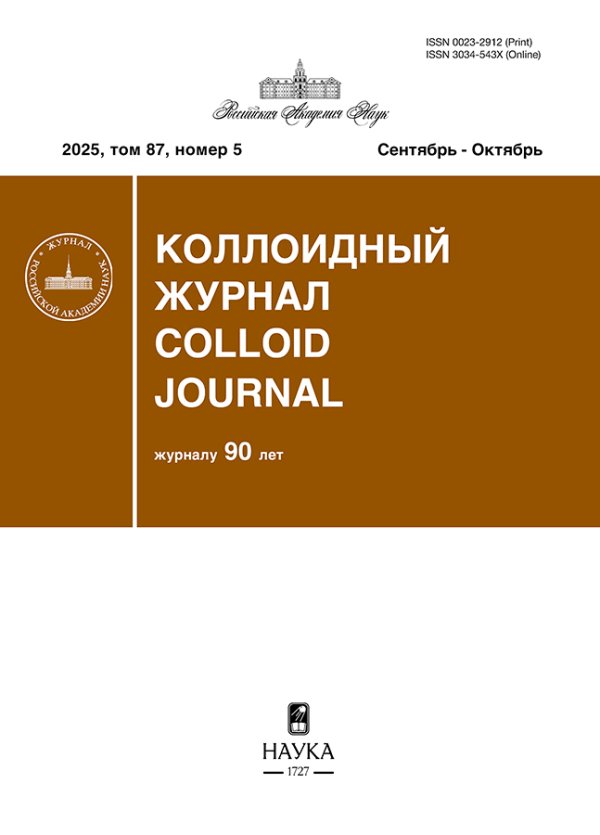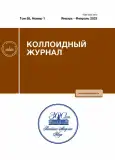THE EXPERIMENTAL STUDY OF EVAPORATION OF WATER AND NANOFLUID DROPLETS ON THE SURFACES OF MATERIALS WITH DIFFERENT THERMAL CONDUCTIVITIES
- Authors: STERLYAGOV A.N.1, NIZOVTSEV M.I.1
-
Affiliations:
- Kutateladze Institute of Thermophysics, Siberian Branch, Russian Academy of Sciences, Novosibirsk, Russia
- Issue: Vol 85, No 1 (2023)
- Pages: 85-92
- Section: Articles
- Submitted: 16.10.2023
- Published: 01.01.2023
- URL: https://journals.rcsi.science/0023-2912/article/view/137206
- DOI: https://doi.org/10.31857/S0023291222600511
- EDN: https://elibrary.ru/KFCLGY
- ID: 137206
Cite item
Full Text
Abstract
The article presents the results of experimental studying evaporation of water and nanofluid droplets on the surfaces of various materials. Plates made of materials with significantly different thermal conductivity coefficients have been used as substrates: copper (λ = 401 W/m °С), Teflon (λ = 0.25 W/m °С), and extruded foamed polystyrene (λ = 0.03 W/m °С). In the experiments, the evaporation of water and nanofluid droplets with a volume of 5 μL has been considered at a constant temperature and humidity of the ambient air. A nanofluid (a mixture of water with gold nanoparticles) has been prepared by laser ablation. The concentration of nanoparticles in the nanofluid is about 0.1 wt %. Infrared thermography has been employed to determine the average temperatures of evaporating droplet surfaces. The results obtained have shown that, for all studied materials, the surface temperature of evaporating water droplets is higher than the temperature of adiabatic evaporation. Therewith, the lower the thermal conductivity coefficient of a substrate material, the lower the surface temperature of the droplet and the longer the time of its evaporation. The performed experiments have shown that the minimum temperature of nanofluid droplets is lower than that of water droplets, and the evaporation time of nanofluid droplets is longer than that of water droplets on the corresponding surfaces.
About the authors
A. N. STERLYAGOV
Kutateladze Institute of Thermophysics, Siberian Branch, Russian Academy of Sciences, Novosibirsk, Russia
Email: sterlyagov@itp.nsc.ru
Россия, 630090, Новосибирск,
ул. Лаврентьева 1
M. I. NIZOVTSEV
Kutateladze Institute of Thermophysics, Siberian Branch, Russian Academy of Sciences, Novosibirsk, Russia
Author for correspondence.
Email: sterlyagov@itp.nsc.ru
Россия, 630090, Новосибирск,
ул. Лаврентьева 1
References
- Ranz W.E., Marshall W.R. Evaporation from drops // Chem. Eng. Prog. 1952. T. 48. № 3. P. 141–146.
- Fuchs N.A. Evaporation and Droplet Growth in Gaseous Media. Pergamon Press, 1959.
- Picknett R.G., Bexon R. The evaporation of sessile or pendant drops in still air // Journal of Colloid and Interface Science. 1977. T. 61. № 2. P. 336–350.
- Law C.K. Recent advances in droplet vaporization and combustion // Progress in energy and combustion science. 1982. T. 8. № 3. P. 171–201.
- Cazabat A.M., Guena G. Evaporation of macroscopic sessile droplets // Soft Matter. 2010. T. 6. № 12. P. 2591–2612.
- Erbil H.Y. Evaporation of pure liquid sessile and spherical suspended drops: a review // Advances in Colloid and Interface Science. 2012. T. 170. № 1–2. P. 67–86.
- Hu H., Larson R.G. Evaporation of a sessile droplet on a substrate // The Journal of Physical Chemistry B. 2002. T. 106. № 6. P. 1334–1344.
- Brutin D., Sobac B., Nicloux C. Influence of substrate nature on the evaporation of a sessile drop of blood // Journal of Heat Transfer. 2012. T. 134. № 6. P. 061101-1–061101-7.
- Кучма А.Е. и др. Динамика испарения бинарной сидячей капли: теория и сравнение с экспериментом для капли раствора серной кислоты // Коллоидный журнал. 2017. Т. 79. № 6. С. 747–755.
- Ozturk T., Erbil H.Y. Evaporation of water-ethanol binary sessile drop on fluoropolymer surfaces: influence of relative humidity // Colloids and Surfaces A: Physicochemical and Engineering Aspects. 2018. T. 553. P. 327–336.
- Chulkova E. V. et al. Elimination of wetting study flaws in unsaturated vapors based on Laplace fit parameters // Surface Innovations. 2020. V. 1. № 10. P. 21–24.
- Бородулин В.Ю. и др. Экспериментальное исследование испарения капель водно-спиртовых растворов // Коллоидный журнал. 2019. Т. 81. № 3. С. 289–295.
- Бородулин В.Ю. и др. Влияние относительной влажности воздуха на испарение капель водного раствора этанола // Коллоидный журнал. 2021. Т. 83. № 3. С. 251–257.
- Терехов В.И., Шишкин Н.Е. Влияние поверхностно-активного вещества на интенсивность испарения подвешенных капель воды // Коллоидный журнал. 2021. Т. 83. № 1. С. 107–113.
- Gatapova E.Y., Semenov A.A., Zaitsev D.V., Kabov O.A. Evaporation of a sessile water drop on a heated surface with controlled wettability // Colloids and Surfaces A: Physicochemical and Engineering Aspects. 2014. 41. P. 776–785.
- Савенко О.А., Лебедев-Степанов П.В. Квазистационарное испарение малой капли жидкости на плоской подложке: аналитическое решение в биполярных координатах // Коллоидный журнал. 2022. Т. 84. № 3. С. 328–337.
- David S., Sefiane K., Tadrist L. Experimental investigation of the effect of thermal properties of the substrate in the wetting and evaporation of sessile drops // Colloids and Surfaces A: Physicochemical and Engineering Aspects. 2007. T. 298. № 1–2. P. 108–114.
- Dunn G.J. et al. The strong influence of substrate conductivity on droplet evaporation // Journal of Fluid Mechanics. 2009. T. 623. P. 329–351.
- Sobac B., Brutin D. Thermal effects of the substrate on water droplet evaporation // Physical Review E. 2012. T. 86. № 2. P. 021602.
- Bazargan V., Stoeber B. Effect of substrate conductivity on the evaporation of small sessile droplets // Physical Review E. 2016. T. 94. № 3. P. 033103.
- Lopes M.C. et al. Influence of the substrate thermal properties on sessile droplet evaporation: Effect of transient heat transport // Colloids and Surfaces A: Physicochemical and Engineering Aspects. 2013. T. 432. P. 64–70.
- Han K. et al. An experimental and theoretical study of the effect of suspended thermocouple on the single droplet evaporation // Applied thermal engineering. 2016. T. 101. P. 568–575.
- Терехов В.И., Шишкин Н.Е. Температура поверхности испаряющихся капель бинарных растворов // Ползуновский вестник. 2010. № 1. С. 55–59.
- Nakoryakov V.E., Misyura S.Y., Elistratov S.L. Boiling crisis in droplets of ethanol water solution on the heating surface // Journal of Engineering Thermophysics. 2013. T. 22. № 1. P. 1–6.
- Bochkareva E.M. et al. Integrated experimental and theoretical study of evaporation process of nonideal solutions // Journal of Physics: Conference Series. IOP Publishing. 2017. T. 891. № 1. P. 012010.
- Высоцкий В.В. и др. Перколяционные переходы в композитных структурах, формирующихся при испарении капель дисперсий наночастиц серебра // Коллоидный журнал. 2011. Т. 73. № 2. С. 173–181.
- Высоцкий В.В. и др. Испарение капель дисперсий наночастиц серебра на металлических поверхностях // Коллоидный журнал. 2014. Т. 76. № 5. С. 578–586.
- Высоцкий В.В. и др. Влияние температуры на процесс формирования кольцевого осадка при испарении капель дисперсий наночастиц серебра // Коллоидный журнал. 2017. Т. 79. № 2. С. 134–141.
- Zaibudeen A.W., Bandyopadhyay R. Correlating the drying kinetics and dried morphologies of aqueous colloidal gold droplets of different particle concentrations // Colloids and Surfaces A: Physicochemical and Engineering Aspects. 2022. T. 646. P. 128982.
- Gan Y., Qiao L. Evaporation characteristics of fuel droplets with the addition of nanoparticles under natural and forced convections // International Journal of Heat and Mass Transfer. 2011. T. 54. № 23–24. P. 4913–4922.
- Дмитриев А.С., Макаров П.Г. Об испарении жидкости из капель коллоидных растворов наночастиц SiO2 и Fe2O3 // Коллоидный журнал. 2015. Т. 77. № 2. С. 144–151.
- Starinskaya E.M. et al. Effect of SiO2 nanoparticle addition on the evaporation of a suspended water droplet // Heat Transfer Research. 2022. T. 53. № 9. P. 43−56.
- Starinskaya E.M. et al. Investigation of heat transfer during evaporation of droplets of Fe3O4 nanofluids from biphilic surfaces // Journal of Physics: Conference Series. IOP Publishing. 2021. T. 2119. № 1. P. 012083.
- Нестеренко А.В. Основы термодинамических расчетов вентиляции и кондиционирования воздуха. Учебное пособие, изд. 3, доп. М.: “Высшая школа”, 1971. 460 с.
- Starinskiy S.V. et al. Comparison of structures of gold nanoparticles synthesized by pulsed laser ablation and magnetron sputtering // Journal of Structural Chemistry. 2017. T. 58. № 8. P. 1581–1587.
- Старинский С.В., Шухов Ю.Г., Булгаков А.В. Влияние размеров наночастиц на спектр экстинкции коллоидных растворов, полученных при лазерной абляции золота в воде // Квантовая электроника. 2017. Т. 47. № 4. С. 343–346.
Supplementary files


















